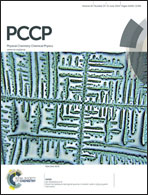Femtosecond spectroscopy reveals huge differences in the photoisomerisation dynamics between azobenzenes linked to polymers and azobenzenes in solution†
Abstract
Femtosecond fluorescence up-conversion spectroscopy of two azobenzenes covalently attached to the side chain or linked by covalent bonds at each end into the main chain of polybutylmethacrylate polymer colloids with different cross-linking ratios reveals dramatic differences in the excited-state dynamics compared to the monomer chromophores in solution due to strong mechanical forces in the complex micronetworks. For the azobenzene derivative DR1 in the polymer side chain, the measurements determined an increase of the mean excited-state lifetime after irradiation at λ = 475 nm to 〈τ〉 = 5.5 ps from 〈τ〉 = 0.5 ps for the monomer. For the cross-linked BAAB in the polymer main chain, an increase of 〈τ〉 was found of more than a factor-of-20. Moreover, with a lifetime of τ = 430 ps, ≈12% of the molecules in the tightly (1 : 10) cross-linked polymer were found to remain in the excited state about 100 times longer than observed for the monomer chromophore. These results are of high relevance for applications of photoswitchable polymer materials.


 Please wait while we load your content...
Please wait while we load your content...